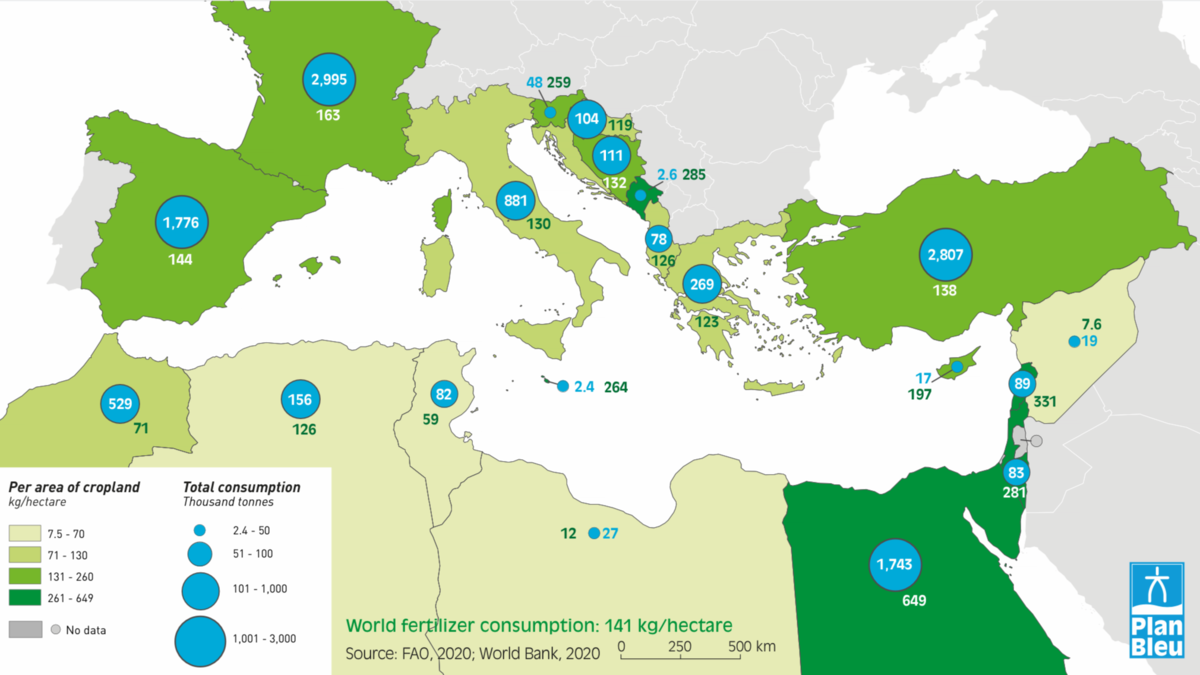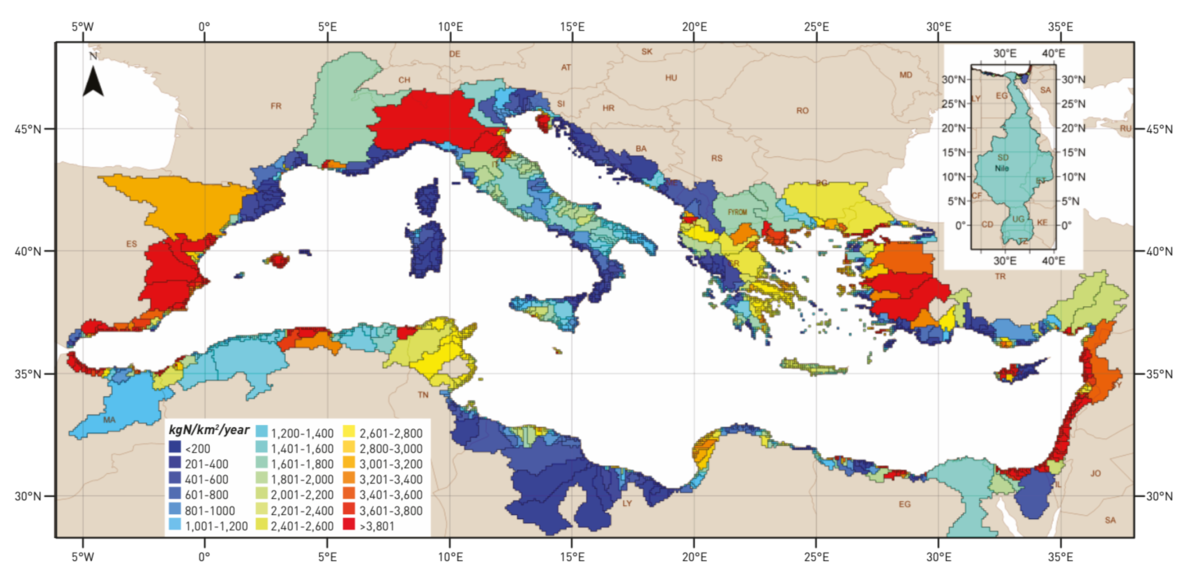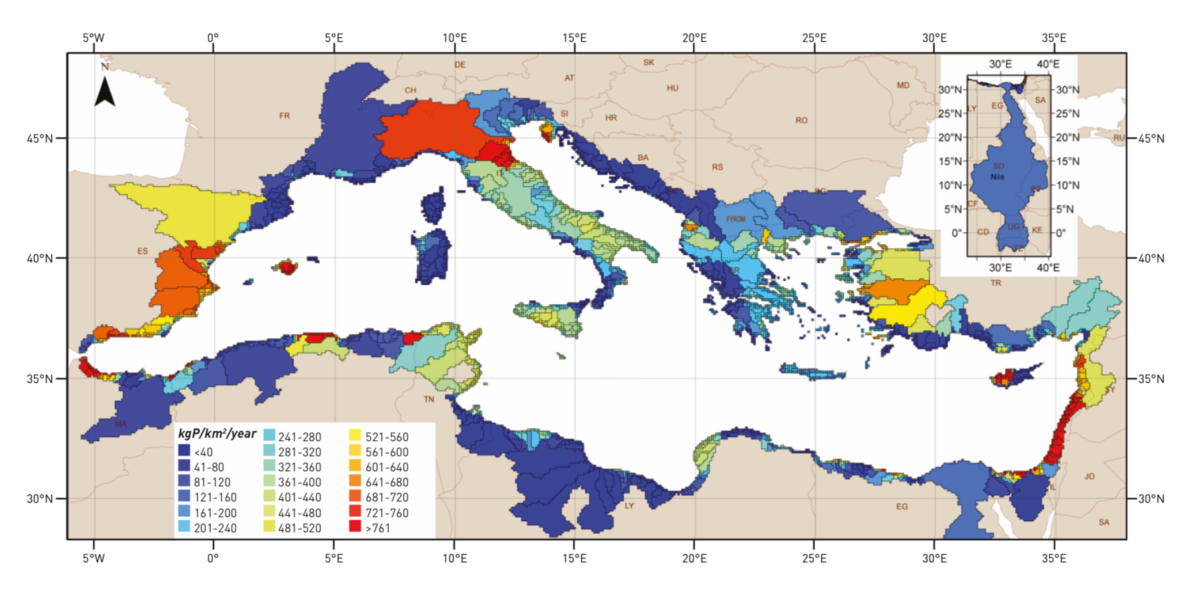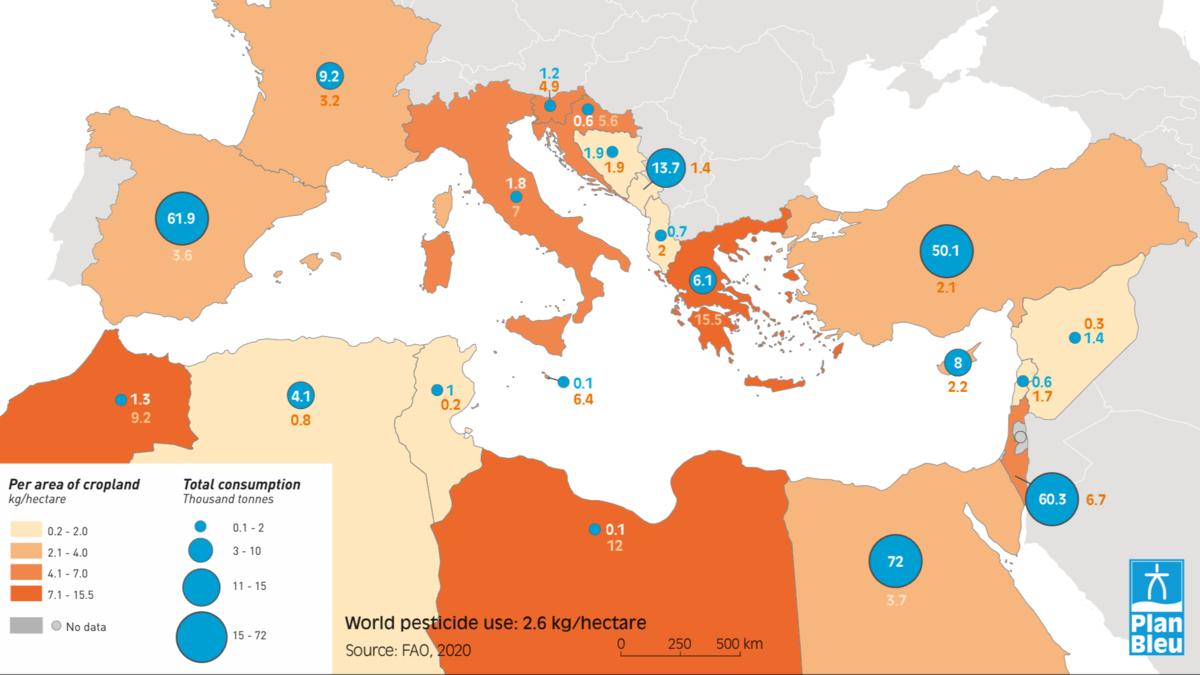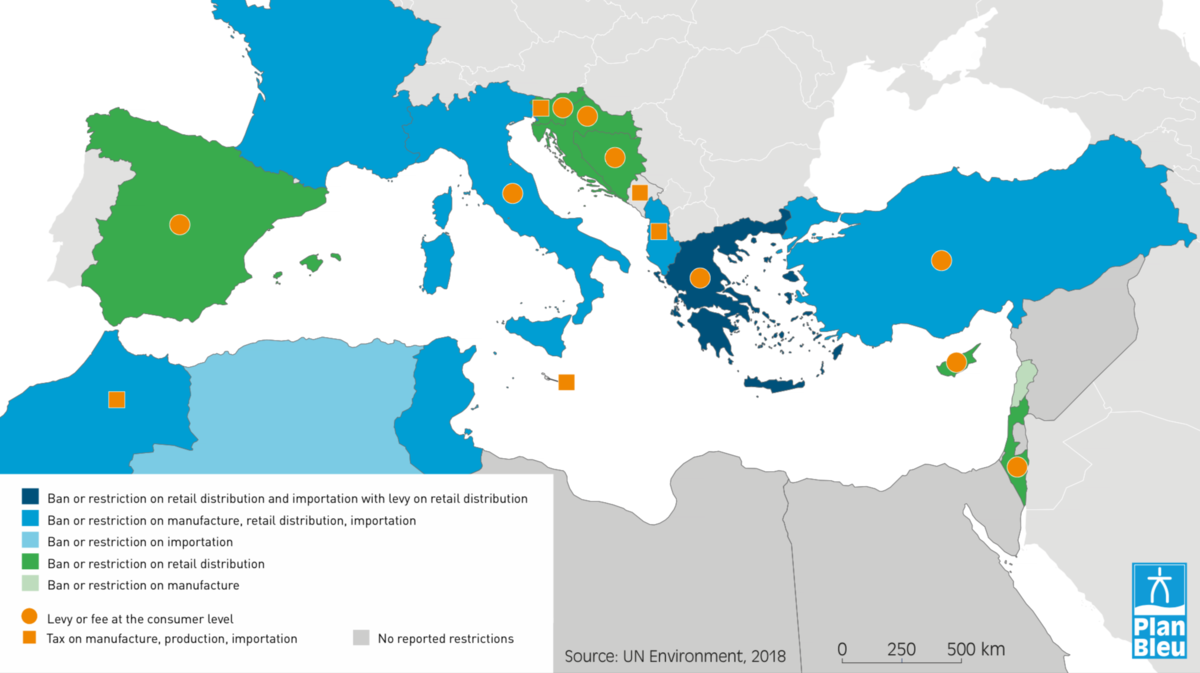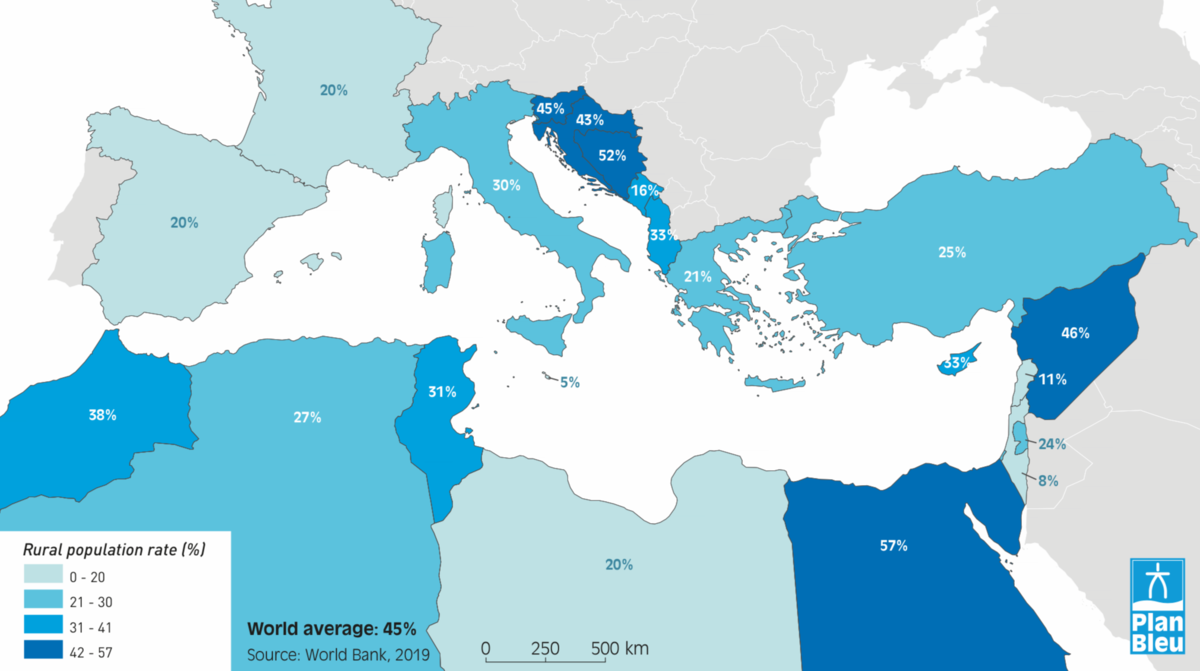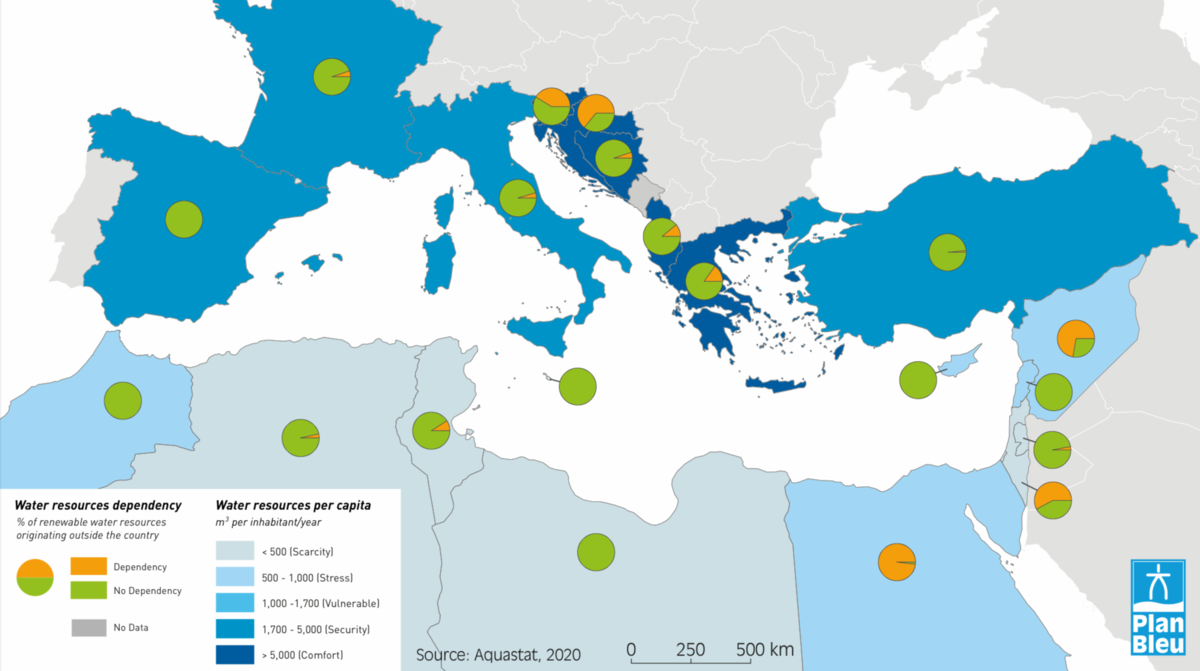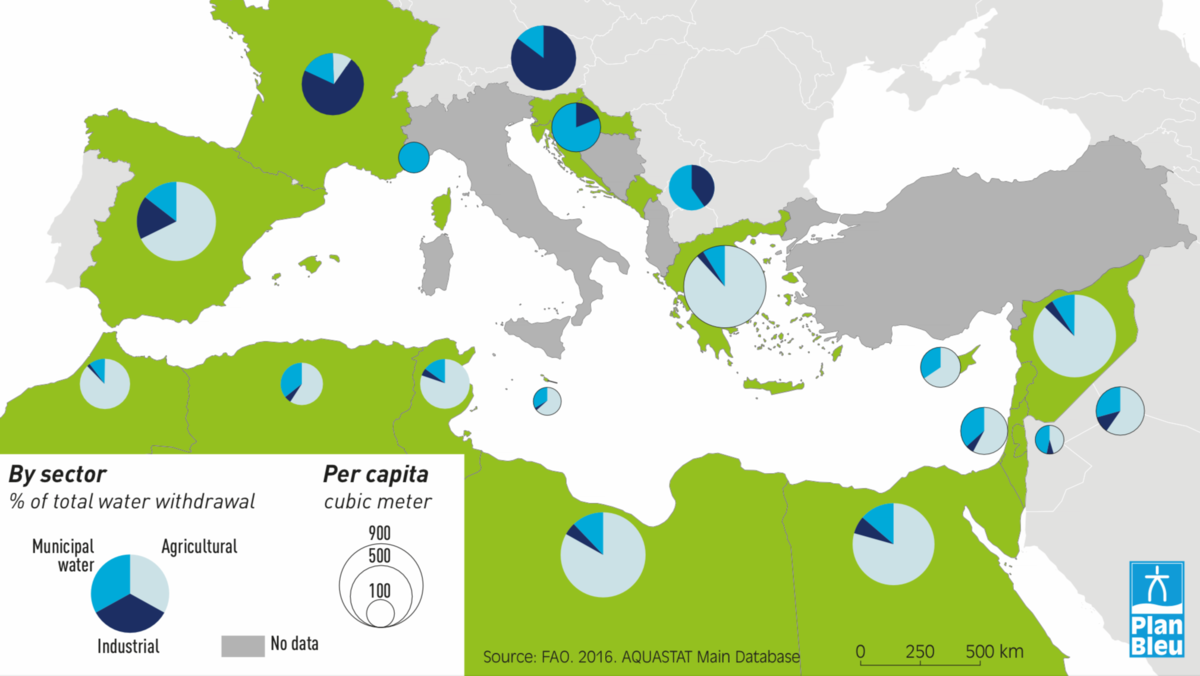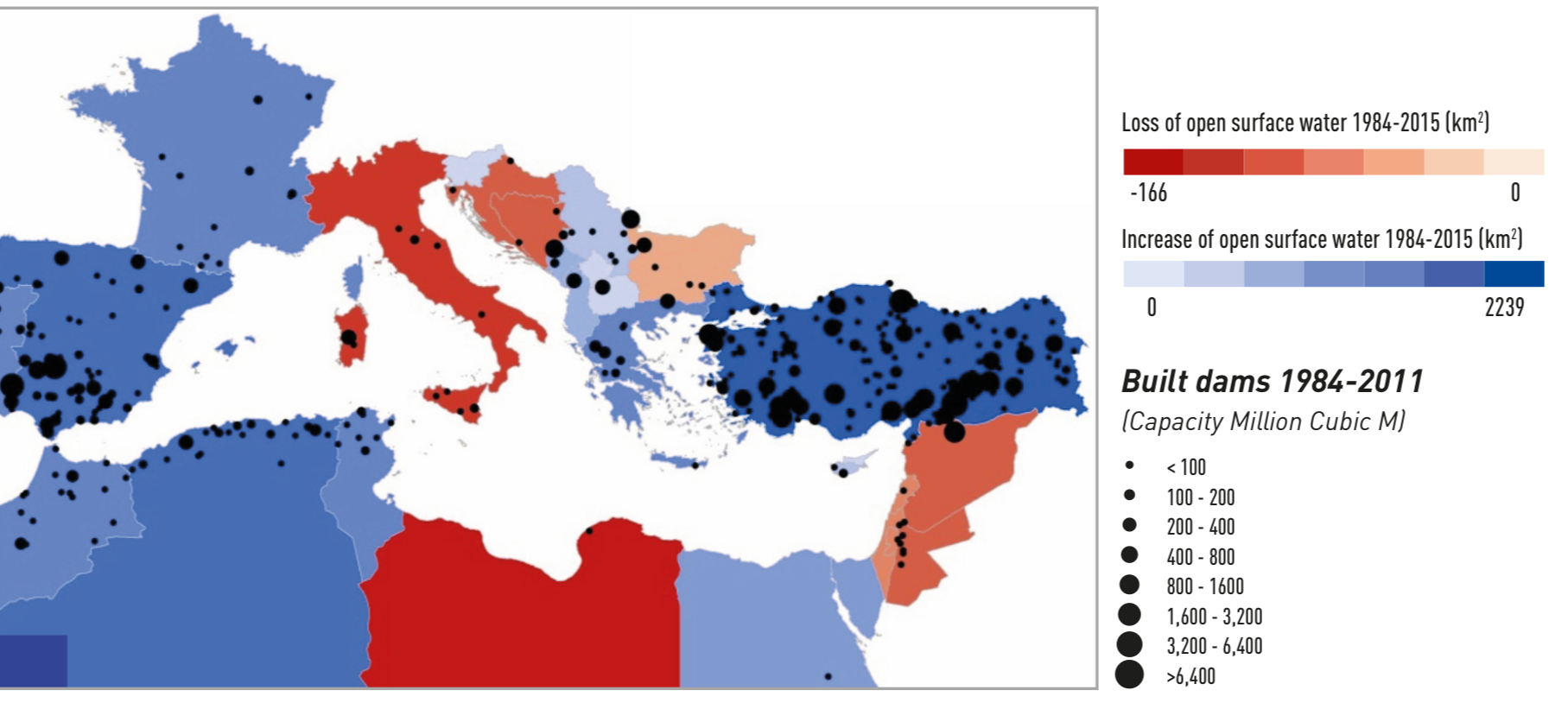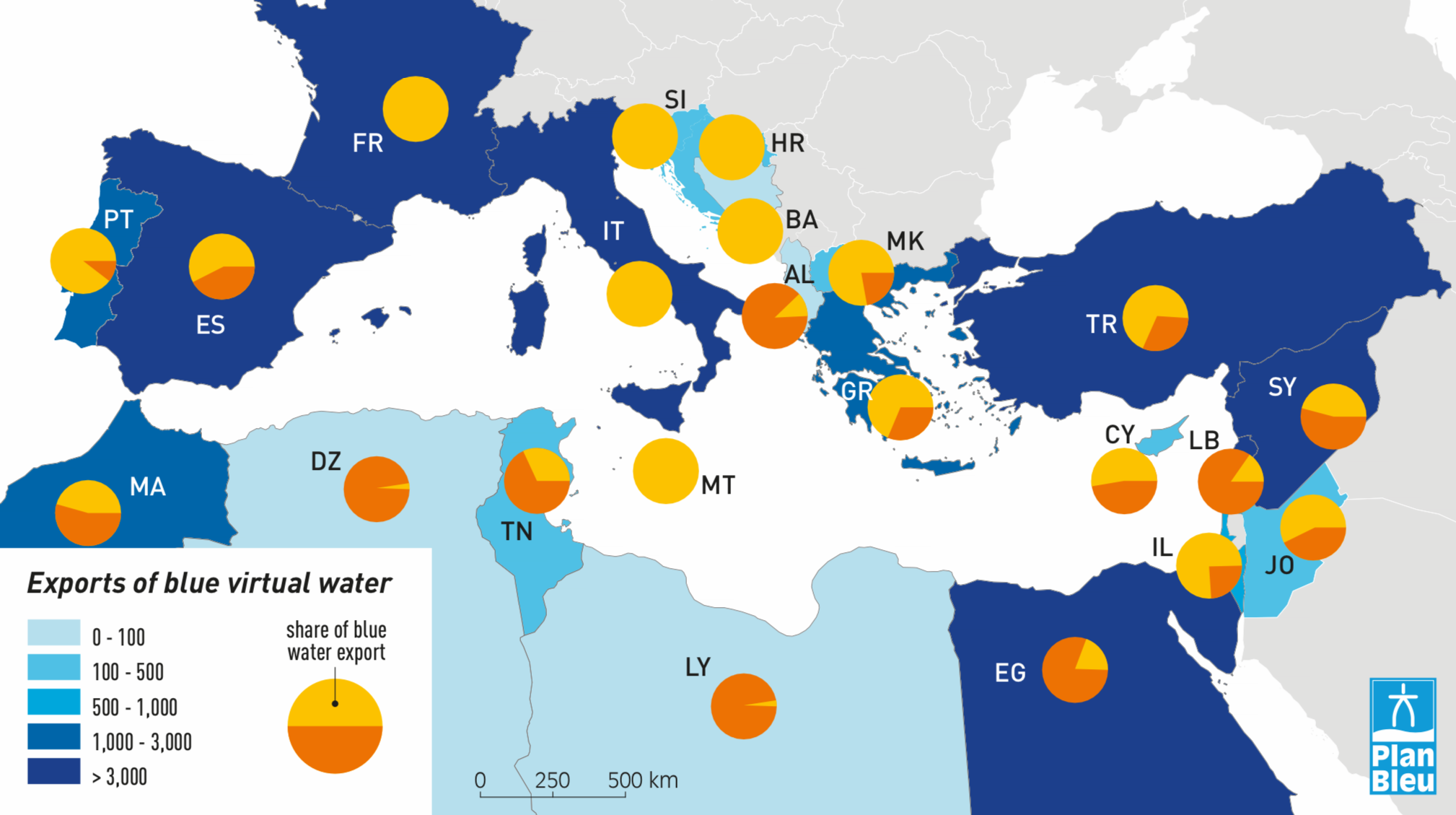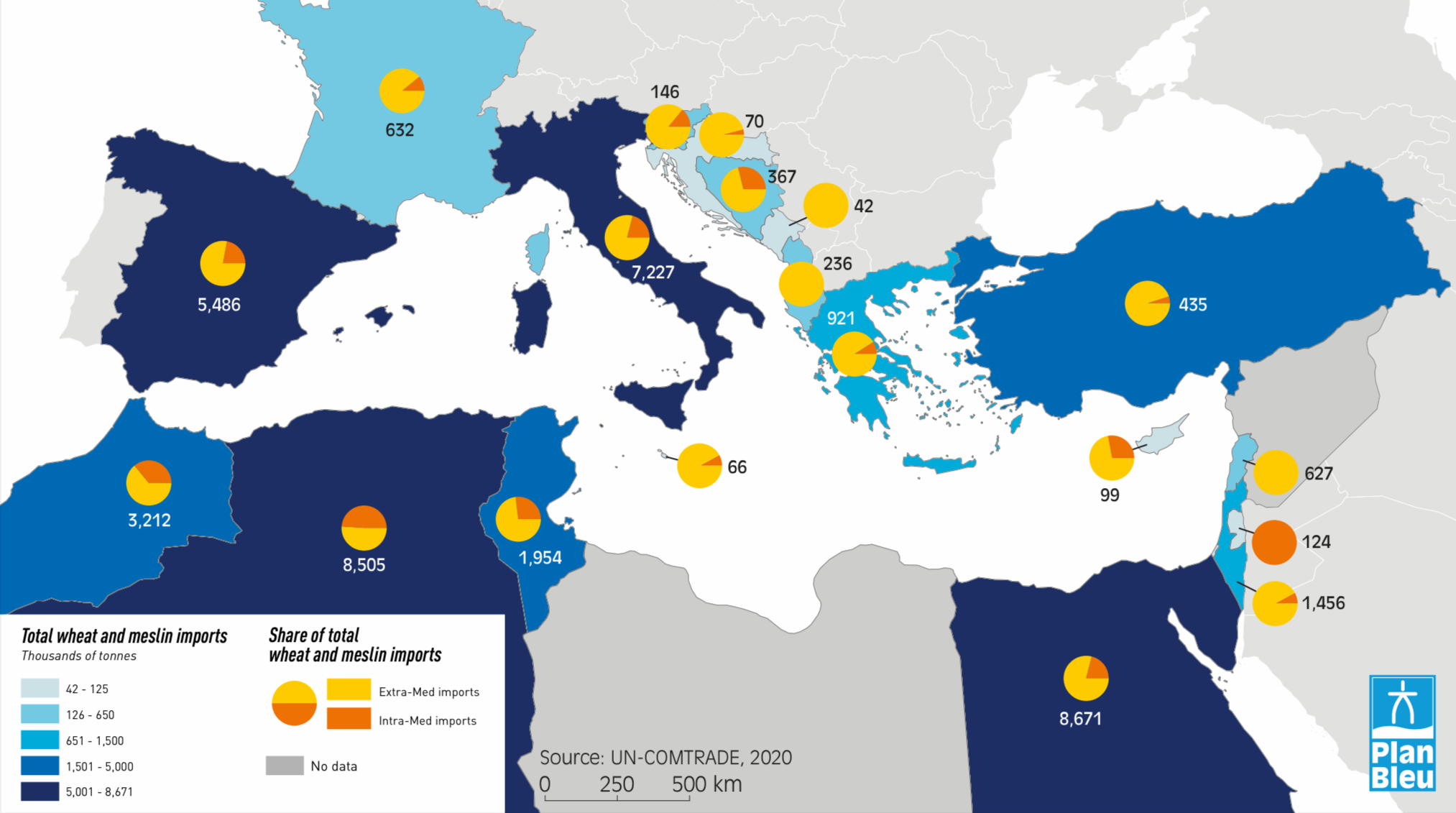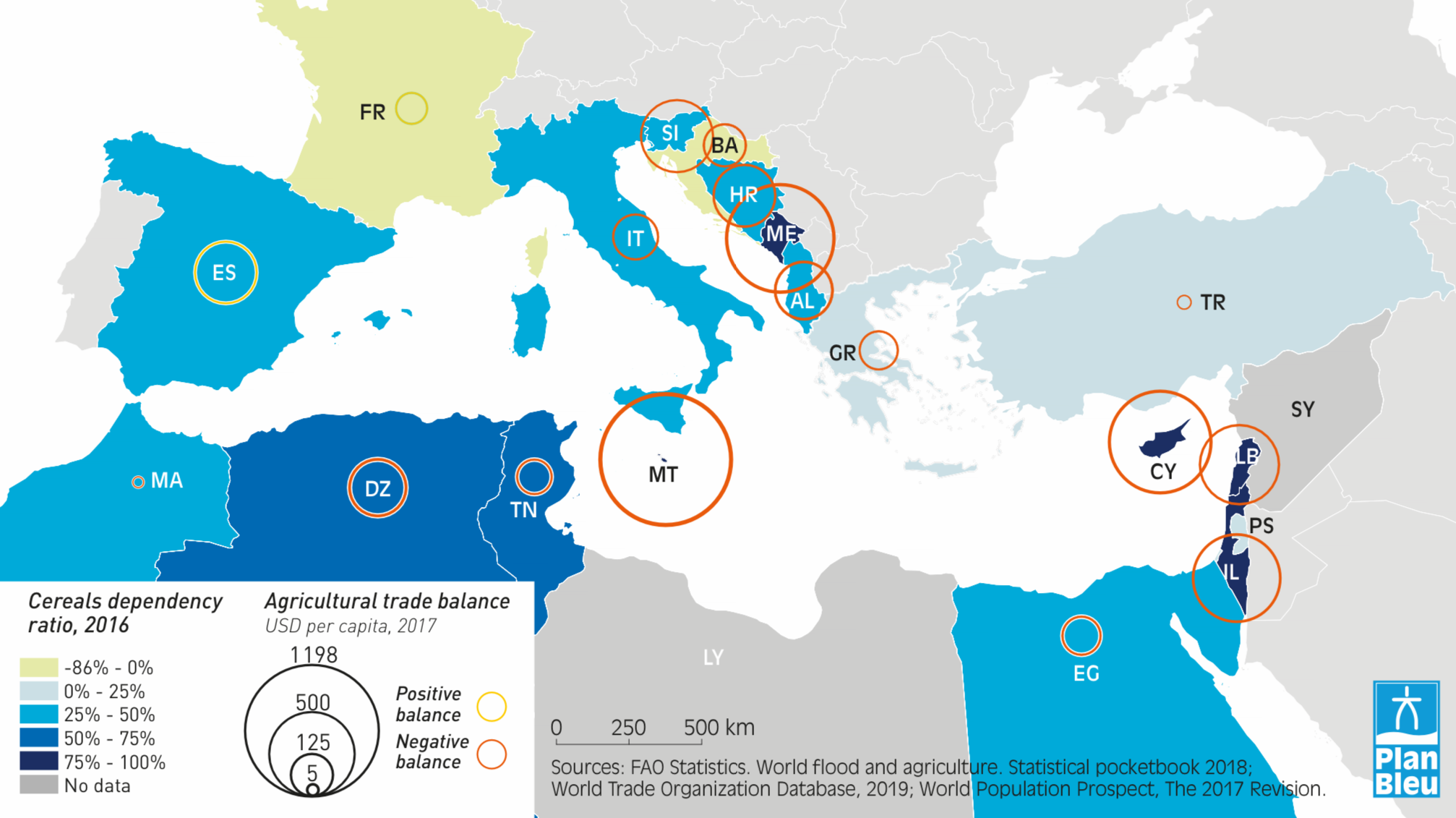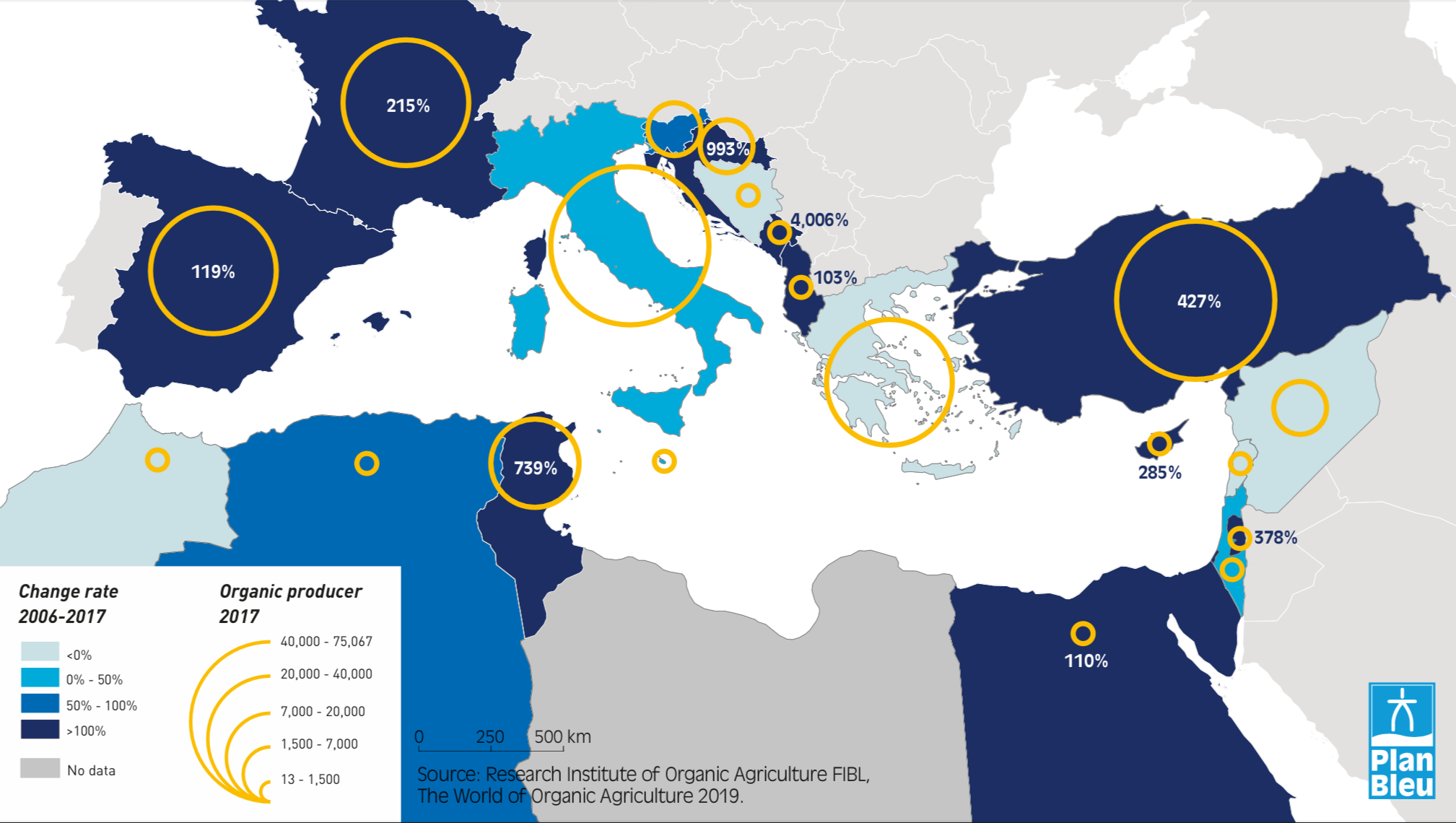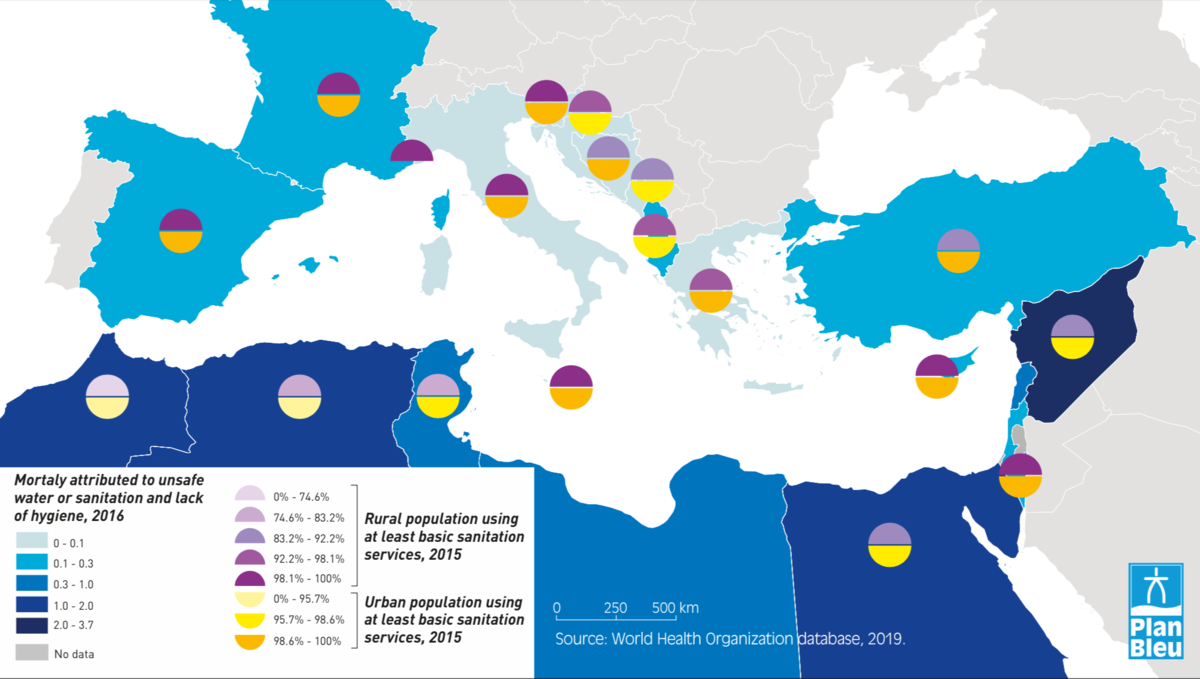Rural & Resources — Maps illustrating the relationship between pressures from human activities and the environmental states
Agricultural use of fertilizers in Mediterranean countries, 2016
The average consumption of fertilizers of countries in the Mediterranean basin increased by 10% between 2002 and 2016, from 160 kg per hectare to 174 kg per hectare of arable land (World Bank, 2020)…
This average is subject to significant differences, ranging from 8 kg per hectare in the Syrian Arab Republic to 649 kg per hectare in Egypt (World Bank, 2020). Around one third of Mediterranean countries show national consumptions of fertilizers above the global average of 141 kg per hectare of arable land (World Bank, 2020).
Agricultural use of pesticides in Mediterranean countries, 2016
The consumption of pesticides in the Mediterranean basin varies largely between countries. In 2016, the average use of pesticides in kilogram per hectare of cropland was below or around the world average…
in most SEMCs except for Israel, Lebanon and the State of Palestine, and generally above the world average in NMCs.
Total and partial bans and taxes on the manufacture, free distribution, and importation of plastic bags
Single-use plastic bags have generally been addressed through bans and economic disincentives, as shown in this map. However, they are still persistent along with other iconic items such as cigarette butts.
Rural population in 2018
Almost all Mediterranean countries are characterized by a decline in the annual growth rate of the rural population, except for Egypt (+ 2%), the State of Palestine (+ 1.8%), Malta (+ 1%), Israel (+ 0.9%), Cyprus (+ 0.9%) and Tunisia (+ 0.2%).
Rural population decline in absolute terms is an unprecedented phenomenon in countries such as Algeria (- 0.4%), or even in countries with a high rural population such as Croatia (- 1%), Montenegro (- 1%), Slovenia (- 0.5%), Albania (- 2.4%) and Turkey (- 0.5%). Egypt remains by far the country where the rural and peasant world is experiencing remarkable demographic growth. With an annual rural population growth rate of 2%, Egypt went from 35 million rural people in 1995, to about 56 million in 2017 (FAO, 2018; World Bank, 2019). The Syrian Arab Republic, which had barely 3 million rural people in 1960, had more than 7.2 million in 1995 and 9.7 million in 2016.
Total renewable water resources per capita in the Mediterranean, 2017
Total Renewable Water Resources (TRWR) are unevenly distributed across Mediterranean subregions: 67% are located in the North, 10% in the South, and 23% in the East, over 20.5% are in Turkey (FAO, 2016a).
These heterogeneities are further emphasized by uneven population growth, as population is stagnating in the water rich North and continues to grow in the water poor South. With less than 500 m3 per capita per year, Algeria, Israel, Libya, Malta, the State of Palestine and Tunisia face absolute water scarcity. With more than 500 m3 but less than 1,000 m3 per capita per year, Cyprus, Egypt, Lebanon, Morocco and the Syrian Arab Republic are water scarce (FAO, 2016a). Most of the NMC population is water-secure, with some countries considered as living in the comfort of water abundance, such as the Balkans.
Water withdrawal by sector and per capita in Mediterranean countries in 2016
The level of water stress differs across countries with three groups:
• Algeria, Egypt, Israel, Libya, the Syrian Arab Republic and Tunisia exploit more than 80% of their available renewable water resources and their level of water stress tends towards serious water shortage;
• Cyprus, Lebanon, Malta, Morocco, Spain and the State of Palestine with exploitation approaching 50% form a group of countries with a risk of water shortage in the future;
• Albania, Bosnia and Herzegovina, Croatia, France, Greece, Italy, Slovenia and Turkey exploit less than 30% of their available renewable water resources, with local (sub-national) disparities.
Loss and increase of open surface water area and number and capacity of dams
The increase in the number and capacity of dams in Mediterranean countries, as well as changing land covers, and increasing pollution, have considerable impacts on downstream ecosystems and the services they provide…
Flow regulation infrastructures affecting land-sea interactions (especially ecological connectivity) are often related to agricultural developments, energy, and water supply, therefore requiring integrated management.
Share of virtual blue water exported from the Mediterranean countries, 1996-2005 (in percentage of the total blue water consumed in the country)
Water-scarce countries with high external water dependency include Malta (92% dependency), Israel (82%), Lebanon (73%) and Cyprus (71%). Not all countries with a large external water footprint are water scarce. In this category are Northern European countries like Slovenia…
They depend upon freshwater resources elsewhere, but their high dependency is not associated with their lack of water resources. These countries have ample room for expanding agricultural production and thus reducing their external water dependency (Mekonnen & Hoekstra, 2011). A number of Mediterranean countries reduce the use of their national water resources (blue water) by importing agricultural and industrial products that are water-intensive in their production. Imports of virtual water associated with international trade of agricultural products or other water uses can help cope with water crises and shortages. A first quantification of virtual water flows related to foreign trade in agricultural products of Mediterranean countries suggests that for some countries, virtual water imported exceeds national exploitable water resources (Fernandez, 2007). This analysis also revealed that some countries facing water stress situations also export a significant part of their irrigation water (blue water). Trade and food security policies thus impact virtual water flows and water uses. In NMCs, Cyprus, Greece and Spain are net virtual blue water exporters. Spain in particular exports large quantities of blue virtual water, due to crop products (Mekonnen & Hoekstra, 2011). When considering overall virtual water, including blue, green and grey waters, Cyprus, Greece and Spain are generally net importers. In the Eastern Mediterranean, Turkey is a net blue water exporter and the leading exporter of virtual blue water in the Mediterranean region. In the Southern Mediterranean, Egypt and Morocco are the countries that export the most virtual blue water, both also being net virtual blue water exporters (Mekonnen & Hoekstra, 2011). The inter-Mediterranean trade of virtual water is low when compared to trade with the rest of the world. The Mediterranean region is the world’s largest importer of cereals. The dependency on imports is a major hazard for food security.
Wheat and meslin imports in Mediterranean countries, 2015
The map shows wheat import volumes between 2011 and 2013, which are some of the highest in the world (particularly for Egypt, which is the largest global importer), the self-sufficiency ratio for soft wheat, and the origin of wheat imports. The proportion of imports from the Mediterranean region was higher in the West than in the East for 2011- 2013.
The agricultural production deficit is primarily due to agroclimatic conditions and the scarcity of arable land (see above) and water resources. Average rainfall is another agricultural difficulty facing Mediterranean agriculture, particularly in Southern countries. Southern countries are affected by natural conditions that are generally more difficult for agriculture. Water resources are scarce and the extension of irrigated land is limited everywhere by non-sustainable agricultural practices and intensive water usage, resulting in groundwater depletion and soil salinization due to lack of drainage.
Agriculture balance and cereal dependency ratio for Mediterranean countries
The main Mediterranean players in the world agricultural trade are Northern countries (Spain, France, Italy and Greece), three North African Countries (Morocco, Egypt and Tunisia) and Turkey in the East…
Finally, Croatia and Slovenia in Eastern Europe, Israel and, to a lesser extent, Lebanon in the Middle East, export fruit and vegetables across Europe and the world.
Although France is one of the main exporters of cereals and dairy products, all Mediterranean countries, except Croatia and Turkey, register a net cereal deficit and a high cereal dependency ratio.
Change in the number of organic farms in Mediterranean countries
Between 2006 and 2017, the number of organic farms has highly increased in Croatia, Egypt, France, Slovenia, Spain, Tunisia and Turkey. Better soil management would result in their enrichment in organic matter, through agroecology, irrigation and land protection.
Impact of inadequate water and sanitation on health in Mediterranean countries, 2015-2016
Inadequate sanitation and access to water or hygiene increase the incidence of diarrheal diseases. Most diarrheal deaths in the world (60%) are caused by unsafe water, sanitation or hygiene (Prüss-Üstün et al. 2016)…
Mortality due to unsafe water, sanitation and hygiene is relatively low in Mediterranean countries, with the highest rate recorded in the Syrian Arab Republic (3.7 deaths for 100,000 population121, compared to the worldwide average of 11.7 deaths per 100,000 population). The figure below presents the health impact of inadequate water and sanitation services in Mediterranean countries. Mortality attributed to unsafe water or sanitation and lack of hygiene is highest in countries in which access to sanitation is lowest.

